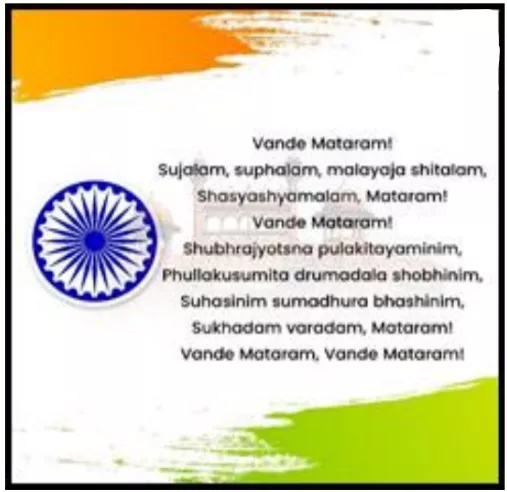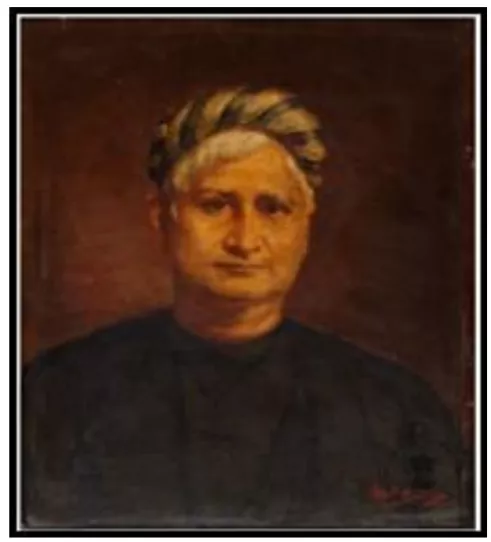Recently, the Indian Prime Minister inaugurated year-long celebrations marking 150 years of Vande Mataram, calling the iconic national song an “enduring symbol of patriotism and unwavering devotion to the nation.”
About the Celebration

- Nationwide Celebrations: As India marks 150 years of Vande Mataram, commemorative events across the country honour its legacy as a song of unity, resistance, and national pride.
- Government-led Commemoration: The Government of India will observe the milestone in four phases, ensuring national, international, and local-level participation, reflecting Vande Mataram’s timeless power to inspire collective patriotism.
About Vande Mataram

- Refers: Vande Mataram is India’s National Song, equal in status to the National Anthem “Jana Gana Mana” that holds immense historical, cultural, and emotional significance in India’s freedom struggle.
- Meaning: The phrase Vande Mataram translates to “I bow to thee, Mother”, symbolising reverence towards the Motherland as divine and nurturing.
- Language and Style: Written in Sanskritised Bengali, it harmonises devotional piety (Bhakti) with nationalist fervour (Deshbhakti).
- Publication: The song first published in literary journal Bangadarshan on 7 November 1875 and was later featured in Bankim’s novel Anandamath (1882).
- Musical Legacy: Rabindranath Tagore set it to music, transforming it into a melodic anthem of awakening.
- Imagery: Through lines like “Sujalam, Suphalam, Malayajasitalam”, the song portrays India’s sacred geography and civilisational grandeur.
Anandamath and the Religion of Patriotism
- Literary Genesis: Vande Mataram was written by Bankimchandra Chattopadhyay on November 7, 1875.
- It was first published in the literary journal Bangadarshan as part of his novel Anandamath. The story revolves around the Santans, warrior-monks dedicated to liberating their sacred Motherland from oppression.
- Their anthem, Vande Mataram, personifies the nation as the divine Mother — compassionate yet commanding, nurturing yet resolute.
- Symbolism of the Three Mothers: In the novel’s temple scene, the Mother is depicted in three forms, symbolising India’s civilisational journey:
- The Mother That Was: Glorious and radiant — representing India’s ancient cultural and spiritual splendour.
- The Mother That Is: Bound and suffering — symbolising colonial subjugation and national decay.
- The Mother That Will Be: Resurrected and triumphant — envisioning India’s freedom and renewed dignity.
- Spiritual Nationalism: Anandamath transformed love of the nation into a sacred duty, introducing the concept of a “Religion of Patriotism.”
- Service to the Motherland was portrayed as an act of worship, equating national liberation with spiritual awakening.
- As Sri Aurobindo later described, “The Mother of his vision held trenchant steel in her seventy million hands — not the bowl of the mendicant,” symbolising strength, not supplication.
- Essence: Vande Mataram thus emerged not merely as a song of rebellion, but as a hymn of spiritual nationalism — sanctifying the political struggle for freedom with devotion to the divine Motherland.
|
Historical Background of Vande Mataram
- Colonial Context: The hymn was composed during British colonial rule, a period marked by national awakening and cultural assertion in Bengal.
- Author’s Vision: Bankim Chandra Chattopadhyay (1838–1894), one of Bengal’s literary pioneers, sought to infuse patriotism through literature.
- Novel Connection: In Anandamath, Vande Mataram is sung by Sanyasis of Bengal, representing the sacred duty of liberating the motherland.
- Cultural Symbolism: The song personified India as the Mother Goddess, blending religious devotion with patriotic consciousness.
- Intellectual Impact: It reflected a synthesis between spirituality and nationalism, defining patriotism as a moral and cultural obligation.
Historical Evolution of Vande Mataram
- 1875: First published as a poem in Bangadarshan, a literary journal founded by Bankim Chandra.
- 1882: Incorporated in Anandamath, which depicted monks (Santans) fighting for the liberation of the Motherland.
- 1896: Rabindranath Tagore set the song to music and sang it at the Indian National Congress session in Calcutta.
- 1905: Adopted as a slogan of resistance during the Swadeshi Movement following the Partition of Bengal.
- 1907: Madam Bhikaji Cama unfurled the first tricolour in Stuttgart with “Vande Mataram” inscribed on it.
|
Role and Contribution of Vande Mataram in Freedom Struggle
- Anthem of National Awakening: Vande Mataram, composed by Bankim Chandra Chattopadhyay in the late 19th century, transformed from a devotional hymn into a national call for freedom.
 It embodied the ideal of Bharat Mata, awakening emotional unity among Indians and inspiring faith in collective nationhood.
It embodied the ideal of Bharat Mata, awakening emotional unity among Indians and inspiring faith in collective nationhood.
- Catalyst of the Swadeshi and Anti-Partition Movement: The song became the rallying cry during the Partition of Bengal (1905).
- On 7 August 1905, thousands at the Calcutta Town Hall sang it during the adoption of the Swadeshi Resolution, symbolising defiance against British policies and sparking mass mobilisation.
- Unifier of Cultural and Social Forces: Vande Mataram united people across class, caste, and region, bridging the gap between bhakti (spiritual devotion) and deshbhakti (patriotism).
- Movements like the Bande Mataram Sampradaya (1905) and events such as Prabhat Pheris and the Barisal Conference (1906) institutionalised it as a spiritual act of nationalism.
- Ideological and Intellectual Influence: Leaders such as Sri Aurobindo and Bipin Chandra Pal elevated the song from protest to philosophy.
- Through the Bande Mataram newspaper (1906), they described it as a “mantra of national regeneration,” linking freedom to moral awakening and self-realisation.
- The song thus nurtured India’s early ideological foundation of nationalism.
- Resistance Against Colonial Suppression: The British administration banned public singing of Vande Mataram in schools and gatherings, seeing it as politically incendiary.
- Students faced fines, arrests, and expulsion, as seen in Rangpur (1905) and Barisal (1906).
- Yet, repression only strengthened its emotional power, spreading it nationwide—from Bengal to Punjab, Bombay, and Tamil Nadu.
- Regional Echoes: Its influence spread beyond Bengal. The Vande Mataram Movement in Gulbarga (1938) defied the Nizam’s ban, symbolising youth-led resistance in princely India.
- Transformation from Song to Slogan: First sung at the 1896 Congress Session by Rabindranath Tagore, Vande Mataram soon became the anthem of India’s national movement.
- Revolutionaries and freedom fighters used it as a battle cry—from Swadeshi marches and Tilak’s deportation protests (1908) to the Azad Hind Government’s proclamations, making it both a song of sacrifice and symbol of sovereignty.
- Global Echoes- The Song Beyond Borders:
- 1907: Madam Bhikaji Cama unfurled the first tricolour flag at Stuttgart, Germany — with “Vande Mataram” inscribed across it.
- 1909: Madan Lal Dhingra, moments before his execution in London, cried out “Bande Mataram,” symbolising sacrifice and fearlessness.
- The same year, Indian patriots in Paris and Geneva launched Bande Mataram magazine to spread the freedom message.
- 1912: Gopal Krishna Gokhale was greeted with chants of Vande Mataram upon his arrival in Cape Town, South Africa.
- These episodes show how the song served as a unifying moral thread connecting India’s global diaspora to the motherland’s cause.
About Bankim Chandra Chatterjee (1838–1894)
- Early Life and Background: Born in 1838 in Naihati, Bengal Presidency (now West Bengal).
- Educated at Hooghly College and later became one of the first graduates of the University of Calcutta.
- Served in the Indian Civil Service, balancing administrative duties with literary pursuits.
 Literary Contributions: Regarded as the father of modern Bengali prose. Literary Contributions: Regarded as the father of modern Bengali prose.-
- His novels reflected the social, moral, and cultural concerns of a colonised Indian society.
- Major works include:
- Durgeshnandini (1865) – India’s first Bengali novel.
- Kapalkundala (1866) – Blended romanticism and spirituality.
- Anandamath (1882) – Introduced Vande Mataram and inspired nationalist awakening.
- Devi Chaudhurani (1884) – Centred on female empowerment and resistance.
- Ideological Vision: Saw literature as a tool for national awakening.
- Propagated the idea of moral and spiritual regeneration as the basis of freedom.
- Envisioned the Motherland as divine, merging patriotism with religious devotion.
- Legacy and Influence: Inspired later thinkers like Sri Aurobindo, Rabindranath Tagore, and Mahatma Gandhi.
- His fusion of literary brilliance and nationalist philosophy laid the foundation for India’s intellectual nationalism.
- Remembered as a cultural architect of modern India, whose works continue to shape patriotic imagination.
|
Constitutional Status and Recognition
- Official Recognition (1950): On 24 January 1950, Dr. Rajendra Prasad, President of the Constituent Assembly, formally declared Vande Mataram as the National Song of India, acknowledging its deep emotional and historical significance.
- Equal Honour: It was accorded equal status with Jana Gana Mana, recognising its pivotal role in shaping India’s national consciousness and inspiring the freedom struggle.
- Inclusive Spirit: The declaration symbolised India’s synthesis of spirituality and secularism, harmonising devotion, diversity, and democracy within the framework of a modern Republic.
- Judicial Interpretation (2006): In M. K. Ramesh v. Union of India (2006), the Supreme Court held that singing Vande Mataram is not legally mandatory but morally desirable, affirming that true patriotism stems from voluntary respect, not enforced compliance.
Controversy and Truncation (1937):
- Background: By the late 1930s, Vande Mataram had become both a nationalist hymn and a point of contention due to its religious imagery in later stanzas.
- Concerns arose that certain verses depicting the Motherland as a goddess might alienate non-Hindu communities, especially amid growing communal tensions.
- Congress Committee Decision: At the 1937 Indian National Congress session, an internal debate led to the formation of a committee comprising Rabindranath Tagore, Jawaharlal Nehru, and Subhas Chandra Bose.
- The committee recommended that only the first two stanzas—the secular invocation of the Motherland—be sung officially at national events.
- Purpose and Pragmatism: The decision aimed to maintain inclusivity and appease the Muslim League, ensuring that Vande Mataram remained a symbol of unity rather than division.
- Criticism and Dissent: Critics, including Netaji Subhas Chandra Bose, viewed the move as diluting the song’s spiritual essence that had inspired the masses during the freedom struggle.
- Many believed the truncation fragmented the song’s emotional wholeness, reflecting the complex balance between faith, nationalism, and politics in pre-Independence India.
Communal Controversy and Gandhi’s Mediation:
- Communal Opposition: In the early 20th century, parts of the Muslim League opposed Vande Mataram for invoking a Hindu deity, with Mohammad Ali Jinnah citing it as proof of cultural exclusion.
- Gandhi’s Reconciliation: Mahatma Gandhi defended its inclusive essence, writing in Harijan (1939), “It never occurred to me that it was a Hindu song.,it was a most powerful battle cry for Hindus and Musalmans alike.”
- Despite Gandhi’s stance, the Congress reaffirmed the 1937 committee’s decision, restricting the song to its first two stanzas—those free from religious connotations. Yet, Vande Mataram became a casualty of deepening communal divides in the 1940s.
|
Legacy and Significance of Vande Mataram
- Historical and Constitutional Legacy: From its literary origin (1875) to constitutional recognition (1950), Vande Mataram traces India’s journey from cultural awakening to nationhood.
- It embodies the constitutional ideal of unity in diversity and the ethical duty of respect (Article 51A(a)), blending spiritual devotion with secular democracy.
- Gender and Symbolism: The song’s Mother imagery symbolises Shakti (strength) and Karuna (compassion)—representing India as both protector and nurturer.
- Through this feminine divinity, Bankim Chandra fused Bhakti and nationalism, inspiring the idea of the Motherland as sacred and women as moral anchors of society.
- Cultural and Artistic Manifestation: Vande Mataram evolved into a cultural movement shaping India’s art, music, and literature. Abanindranath Tagore’s Bharat Mata (1905) visualised its essence; Tagore and Paluskar popularised it musically; A.R. Rahman’s Maa Tujhe Salaam (1997) revived its spirit for modern India.
- Translations across Indian languages and its cinematic portrayal in Anand Math (1952) made it a pan-Indian symbol of unity.
- Ethical and Philosophical Essence: The song merges Bhakti (devotion) with Shakti (power), equating service to the nation with worship (Nishkama Karma).
- It gave rise to spiritual nationalism, while Tagore’s caution against militant nationalism ensured a moral, inclusive, and humane patriotic ideal.
- Global and Soft Power Resonance: Unlike Western anthems rooted in monarchy or militarism, Vande Mataram expresses moral and civilisational pride.
- From Madam Cama’s 1907 tricolour in Stuttgart to the 150-year global celebrations, it has become a symbol of India’s soft power, connecting the diaspora emotionally to their homeland.
- Contemporary and Ecological Relevance: The initiative “Vande Mataram: Salute to Mother Earth” links patriotism with environmental consciousness, promoting eco-patriotism through tree plantations and public art.
- The PM’s reinterpretation of “Kamala and Vimala” (grace) and “Durga” (strength) captures the dual spirit of compassion and courage in modern India.
- Civic and Cultural Continuity: As a living heritage, Vande Mataram continues to inspire self-reliance, service, and unity, aligning with Atmanirbhar Bharat and Ek Bharat Shreshtha Bharat.
- It stands as a moral compass in the Amrit Kaal, guiding citizens toward harmony, sustainability, and collective progress.
National Song vs. National Anthem- A Comparative Perspective
| Aspect |
Vande Mataram (National Song) |
Jana Gana Mana (National Anthem) |
| Author & Composition |
- Bankim Chandra Chatterjee (1875); part of Anandamath, symbolising resistance and spiritual nationalism.
|
- Rabindranath Tagore (1911); written to celebrate India’s unity and divine guidance.
|
| Language & Tone |
- Sanskritised Bengali; devotional and emotional, symbolising the divinity of the Motherland.
|
- Highly Sanskritised Bengali; solemn, inclusive, and formal in tone.
|
| Core Theme |
- Fusion of Bhakti (devotion) and Deshbhakti (patriotism); reverence to the Motherland as Goddess.
|
- Celebration of India’s unity, sovereignty, and federal harmony under one destiny.
|
| Adoption & Status |
- Declared National Song on 24 January 1950; accorded equal honour with the National Anthem.
|
- Adopted as National Anthem on 24 January 1950; represents the Republic formally at national and international events.
|
| Usage Protocol & Legal Standing |
- No fixed duration or mandatory etiquette; not governed by law, but held in equal esteem. Deeply respected as per Presidential declaration, though voluntary in observance.
|
- Governed by the Prevention of Insults to National Honour Act, 1971; has a formal duration of 52 seconds and legally prescribed performance protocol.
|
| Cultural Role |
- Embodies spiritual nationalism and emotional unity of the freedom struggle.
|
- Symbolises constitutional patriotism and sovereign dignity of independent India.
|
| Essence |
- A hymn of reverence — “I bow to thee, Mother” — evoking devotion and sacrifice.
|
- A pledge of unity — “Thou art the ruler of the minds of all people” — evoking discipline and harmony.
|
Conclusion
Vande Mataram remains the soul of Indian nationalism, blending devotion, unity, and strength. As India marks 150 years, it stands as both a salutation and a summons — to honour the Motherland through service, harmony, and sustainability.
![]() 8 Nov 2025
8 Nov 2025



 It embodied the ideal of Bharat Mata, awakening emotional unity among Indians and inspiring faith in collective nationhood.
It embodied the ideal of Bharat Mata, awakening emotional unity among Indians and inspiring faith in collective nationhood.

